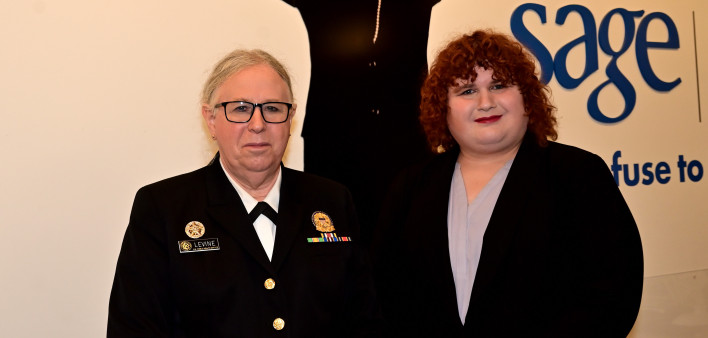Federal HIV testing guidelines recommend that everyone ages 13 to 64 be tested for HIV at least once as part of routine health care and that folks with certain risk factors get tested at least annually. But why stop at age 64? The age limit means missing the chance to catch and treat undiagnosed cases among seniors and creates barriers to sexual health care for this population. That’s why members of SAGE (Advocacy & Services for LGBTQ+ Elders) are urging the Centers for Disease Control and Prevention (CDC) to remove the upper age limit of its HIV testing guidelines.
A huge thank you to @HHS_ASH & @RepJerryNadler for visiting SAGE and listening to the voices of our community! Let’s collaborate to remove the upper age limit in the @CDCgov HIV testing guidelines and prioritize sexual health needs of older adults. #HIVPrevention #HealthyAging pic.twitter.com/CgxQouvwzG
— SAGE USA (@sageusa) June 16, 2023
To promote the issue, SAGE members recently met in New York City with Admiral Rachel Levine, the assistant secretary for health for the U.S. Department of Health and Human Services (the CDC is part of the Department of Health), and U.S. Representative Jerrold Nadler, a Democratic congressman from New York City, along with other leaders in the field. Advocates across the country attended the in-person meeting via Zoom and shared their personal stories about barriers to HIV testing for older citizens.
“I learned I had AIDS at age 75,” recounted one participant, “but no one had tested me all these years even though I had said [to caregivers that] I had sex with men and women when I was younger. I’m now 82. Knowing your status saves lives.”
Others told similar stories, tales of feeling unwell and experiencing numerous mysterious symptoms until finally being diagnosed with HIV—and often AIDS. One man, who described himself as heterosexual and married, said that after they ran several tests, doctors told him that he had non-Hodgkin lymphoma, a type of blood cancer but that his ill health was probably made worse by his HIV. The man had no idea he had been living with HIV nor did he know when he contracted it. Thanks to chemotherapy, his cancer has been successfully treated, and now that he’s taking antiretrovirals, his HIV is undetectable.
Another man disclosed that he began experimenting sexually later in life, after becoming more aware of gay culture thanks to the internet. Although still married to his longtime wife, he now explores sexual relationships with other men. Aiming to do so in a healthy manner, he is now on PrEP, or pre-exposure prophyalxis, to prevent HIV, and he gets tested regularly. His story illustrates another point: Many older people enjoy healthy, active sex lives and as such need HIV testing and education.
According to national data, 10% of people who tested HIV positive in 2019 were 55 and older. What’s more, older people diagnosed with HIV are likely to have late-stage disease, meaning that they have been living with the virus for several years.
If the CDC guidelines were to recommend HIV testing for older Americans, SAGE members note, more health care providers would be aware of the issue and order more tests. Although the CDC guidelines are recommendations—not requirements—the awareness and education that come with changing the guidelines would help remove barriers to testing for this population.
In addition, removing the upper age limit to HIV testing recommendations will help the nation meet the goals of the Ending the HIV Epidemic: A Plan for America initiative, which was launched in 2019 and aims to lower new HIV rates by 75% by 2025 and by 90% by 2030. This would amount to fewer than 3,000 HIV cases a year. “Reducing new infections to this level,” according to the initiative, “would essentially mean that HIV transmissions would be rare and meet the definition of ending the epidemic.” Similarly, the National HIV/AIDS Strategy, recently updated for 2022 to 2025, also aims to reduce new HIV infections by 75% by 2025 and by 90% by 2030 but lays out different objectives and strategies for reaching those targets. To learn more, see “What’s New in the Updated National HIV/AIDS Strategy?”
A CDC representative attended the SAGE meeting via Zoom and noted that the health agency would be updating the testing guidelines—but cautioned that the process is lengthy (you can learn more about the CDC’s standards here).
For related information, see the “HIV and Aging” section of the POZ Basics on HIV and AIDS, and check out the data in the article “National HIV/AIDS and Aging Awareness Day 2022” (the day is marked each September 22). That article lists several reasons why older people may be living with undiagnosed HIV:
- Health care providers do not always test older people for HIV and may miss diagnosis during routine checkups.
- People who are 50 years or older may mistake signs of HIV for the aches and pains of normal aging.
- They are less likely than younger people to get tested.
- Older adults know less about HIV than younger people and may not know how it spreads or the importance of using condoms, not sharing needles and getting tested for HIV.
- Older people are less likely than younger people to talk about their sex lives or drug use with their health care providers.
- Health care providers may not ask older patients about their sex lives or drug use or talk to them about risky behaviors.
- The stigma of HIV may be more severe among older persons, leading them to avoid getting tested or hide their diagnosis from family and friends.







1 Comment
1 Comment